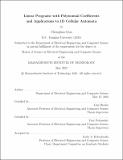Linear Programs with Polynomial Coefficients and Applications to 1D Cellular Automata
Author(s)
Guo, Chenghao
DownloadThesis PDF (938.5Kb)
Advisor
Bresler, Guy
Polyanskiy, Yury
Terms of use
Metadata
Show full item recordAbstract
Given a matrix A and vector b with polynomial entries in d real variables δ=(δ₁,…,δ subscript d) we consider the following notion of feasibility: the pair (A,b) is locally feasible if there exists an open neighborhood U of 0 such that for every δ∈U there exists x satisfying A(δ)x≥b(δ) entry-wise. For d=1 we construct a polynomial time algorithm for deciding local feasibility. For d≥2 we show local feasibility is NP-hard.
As an application (which was the primary motivation for this work) we give a computer-assisted proof of ergodicity of the following elementary 1D cellular automaton: given the current state ηₜ∈{0,1}ℤ the next state ηₜ₊₁(n) at each vertex n∈ superscript ℤ is obtained by ηₜ₊₁(n)=NAND(BSCδ(ηₜ(n−1)),BSCδ(ηt(n))). Here the binary symmetric channel BSCδ takes a bit as input and flips it with probability δ (and leaves it unchanged with probability 1−δ). It is shown that there exists 𝛿₀ > 0 such that for all 0 < 𝛿 < 𝛿₀ the distribution of 𝜂ₜ converges to a unique stationary measure irrespective of the initial condition 𝜂₀.
We also consider the problem of broadcasting information on the 2D-grid of noisy binary-symmetric channels BSCδ, where each node may apply an arbitrary processing function to its input bits. We prove that there exists δ′₀>0 such that for all noise levels 0<δ<δ′₀ it is impossible to broadcast information for any processing function, as conjectured in Makur, Mossel, Polyanskiy (ISIT 2021).
Date issued
2022-05Department
Massachusetts Institute of Technology. Department of Electrical Engineering and Computer SciencePublisher
Massachusetts Institute of Technology